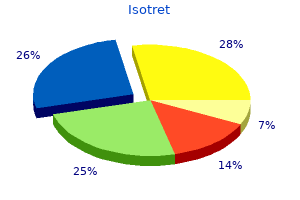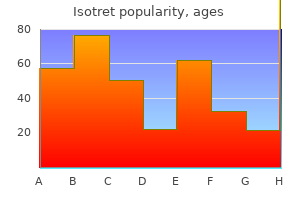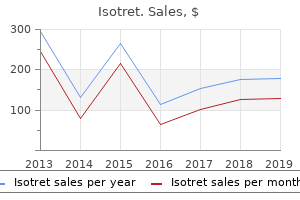CLINICAL,FORENSIC,AND ETHICS CONSULTATION IN MENTAL HEALTH
Isotret
"Order generic isotret pills, skin care 4u".
By: R. Cyrus, M.S., Ph.D.
Deputy Director, Central Michigan University College of Medicine
Barnes D skin care untuk kulit berjerawat isotret 10 mg on line, Corp M acne 10 purchase 40 mg isotret free shipping, Loutit J skin care homemade cheap 30mg isotret overnight delivery, Neal F: Treatment of murine leukaemia with x-rays and homologous bone marrow: Preliminary communication acne problems buy discount isotret 30mg. Barnes D, Loutit J: Treatment of murine leukaemia with x-rays and homologous bone marrow. In Ferrara J, Deeg H, Burakoff S, editors: Graft-vs-host illness, ed 2, New York, 1997, Marcel Dekker, Inc. Nevo S, Enger C, Swan V, et al: Acute bleeding after allogeneic bone marrow transplantation: Association with graft versus host disease and effect on survival. Gorak E, Geller N, Srinivasan R, et al: Engraftment syndrome after nonmyeloablative allogeneic hematopoietic stem cell transplantation: Incidence and results on survival. Korngold R, Sprent J: Purified T cell subsets and lethal graft-versus-host illness in mice. Sun Y, Tawara I, Toubai T, et al: Pathophysiology of acute graft-versushost illness: Recent advances. Goulmy E: Minor histocompatibility antigens: From transplantation problems to remedy of cancer. Fontaine P, Roy-Proulx G, Knafo L, et al: Adoptive transfer of minor histocompatibility antigen-specific T lymphocytes eradicates leukemia cells with out causing graft-versus-host disease. Ruggeri L, Capanni M, Urbani E, et al: Effectiveness of donor natural killer cell alloreactivity in mismatched hematopoietic transplants. Fefer A, Sullivan K, Weiden P: Graft versus leukemia effect in man: the relapse price of acute leukemia is decrease after allogeneic than after syngeneic marrow transplantation. Hempel L, Korholz D, Nussbaum P, et al: High interleukin-10 serum levels are related to deadly end result in patients after bone marrow transplantation. Sato K, Yamashita N, Baba M, et al: Regulatory dendritic cells shield mice from murine acute graft-versus-host disease and leukemia relapse. Chorny A, Gonzalez-Rey E, Fernandez-Martin A, et al: Vasoactive intestinal peptide induces regulatory dendritic cells that stop acute graft-versus-host disease while sustaining the graft-versus-tumor response. Merad M, Hoffmann P, Ranheim E, et al: Depletion of host Langerhans cells before transplantation of donor alloreactive T cells prevents skin graft-versus-host illness. Nachbaur D, Kircher B, Eisendle K, et al: Phenotype, perform and chimaerism of monocyte-derived blood dendritic cells after allogeneic haematopoietic stem cell transplantation. Tawara I, Nieves E, Liu C, et al: Host basophils are dispensable for induction of donor T helper 2 cell differentiation and severity of experimental graft-versus-host disease. Korngold R, Sprent J: Negative selection of T cells inflicting deadly graftversus-host illness throughout minor histocompatibility limitations. Beilhack A, Schulz S, Baker J, et al: In vivo analyses of early occasions in acute graft-versus-host illness reveal sequential infiltration of T-cell subsets. Korngold R, Sprent J: Features of T cells causing H-2 restricted lethal graft-vs-host disease throughout minor histocompatibility limitations. Spierings E, Drabbels J, Hendriks M, et al: A uniform genomic minor histocompatibility antigen typing methodology and database designed to facilitate scientific functions. Maeda Y, Tawara I, Teshima T, et al: Lymphopenia-induced proliferation of donor T cells reduces their capacity for causing acute graftversus-host illness. Zhang Y, Joe G, Hexner E, et al: Alloreactive memory T cells are liable for the persistence of graft-versus-host disease. Wekerle T, Kurtz J, Ito H, et al: Allogeneic bone marrow transplantation with co-stimulatory blockade induces macrochimerism and tolerance with out cytoreductive host treatment. Centers for Disease Control and Prevention; Infectious Diseases Society of America; American Society of Blood and Marrow Transplantation: Guidelines for stopping opportunistic infections among hematopoietic stem cell transplant recipients. Reddy P, Teshima T, Kukuruga M, et al: Interleukin-18 regulates acute graft-versus-host illness by enhancing Fas-mediated donor T cell apoptosis. Pan L, Delmonte J, Jalonen C, et al: Pretreatment of donor mice with granulocyte colony-stimulating issue polarizes donor T-lymphocytes toward type-2 cytokine production and reduces severity of experimental graft-versus-host illness. Nikolic B, Lee S, Bronson R, et al: Th1 and Th2 mediate acute graftversus-host disease, every with distinct end-organ targets. Dutt S, Tseng D, Ermann J, et al: Naive and memory T cells induce various varieties of graft-versus-host disease. Harada N, Takagi K, Baba K, et al: Biodegradation of diphenylarsinic acid to arsenic acid by novel soil micro organism isolated from contaminated soil. Via C, Nguyen P, Shustov A, et al: A major position for the Fas pathway in acute graft-versus-host illness.

The two human Paneth cell -defensin genes map to 8p21�8pter skin care japanese product buy isotret 10 mg with mastercard, and the mouse genes are syntenic and located on the proximal area of chromosome eight acne 9dpo cheap isotret. In all cases skin care 0-1 years buy isotret, probably the most distal (3-) exons of -defensin genes code for the functional -defensin peptide acne 22 years old purchase isotret 20mg online. Paneth cell -defensins derive from ~10 kDa prepropeptides that comprise canonical sign sequences, usually acidic proregions, and a ~3. Pro-defensins lack bactericidal activity and have reduced capacity to bind to and permeabilize model membrane methods till activated proteolytically by particular changing proteinases. Although secreted solely by Paneth cells in the small intestine, microbicidal -defensins of Paneth cell origin are ample in mouse distal colonic lumen as a end result of their inherent resistance to proteolysis. Although microbial numbers are orders of magnitude larger in colon than in small intestine, colonic luminal -defensins and perhaps additional Paneth cell granule constituents might influence the resident colonic microflora and mucosal immunity. Thus, a reduction in luminal -defensins ensuing from disrupted Paneth cell homeostasis or Paneth cell deficiency may skew the resident microbiota towards a more proinflammatory composition thereby contributing to illness. Mucosal immunity could presumably be compromised by deficient -defensin levels, defects in crypt homeostasis that impair Paneth cell supply of secretory granules, impaired solubility of -defensins and secretory proteins following release into the crypt microenvironment,one hundred and five,234 or deficient supply of Paneth-cell-derived signaling molecules required to sustain the Lgr5 crypt stem cell population. Red dashed traces define the boundaries of particular person cells, and the asterisk indicates nucleus of normal progenitor cells. Red dotted circles denote aggregated granules and purple arrows indicating granules of irregular measurement and staining. Paneth cells of mice that are hypomorphic for Atg16l1 are faulty in secretion, activate expression of proinflammatory mediators (see Section forty four. In addition, extreme disruption of the unfolded protein response by deletion of Xbp1 in epithelial cells induces large Paneth cell dysbiosis, apoptosis, and fulminant ileitis. Collectively, these research show that a range of genetic defects can disrupt Paneth cell homeostasis selectively with associated ileitis that mimics grownup human illness. The inset exhibits neutrophils (asterisk) surrounding crypts harboring irregular Paneth cells. A key position for autophagy and the autophagy gene Atg16l1 in mouse and human intestinal Paneth cells. Reciprocal interactions between commensal bacteria and gamma delta intraepithelial lymphocytes during mucosal harm. Morphologic heterogeneity of mouse Paneth cell granules before and after secretory stimulation. Monzon-Casanova E, Steiniger B, Schweigle S, Clemen H, Zdzieblo D, Starick L, et al. Secretory phospholipase A2 is the principal bactericide for staphylococci and other gram-positive bacteria in human tears. Use of fetal intestinal isografts from normal and transgenic mice to study the programming of positional data alongside the duodenal-to-colonic axis. Epithelial cell differentiation in normal and transgenic mouse intestinal isografts. Human intestinal improvement in a severe-combined immunodeficient xenograft mannequin. Conventional patterns of human intestinal proliferation in a severe-combined immunodeficient xenograft model. Dose-time-dependent histological modifications following irradiation of the small gut of rats. Effect of live and heat-killed bacteria on the secretory exercise of Paneth cells in germ-free mice. Identification of xanthine dehydrogenase/xanthine oxidase as a rat Paneth cell zinc-binding protein. Immunohistochemical localization of cysteine-rich intestinal protein in rat small gut. Detection of deoxyribonuclease I alongside the secretory pathway in Paneth cells of human small intestine.

The extracellular calcium sensing receptor is required for cholecystokinin secretion in response to L-phenylalanine in acutely isolated intestinal I cells acne laser treatment buy isotret us. Proteins however not amino acids skin care korean brand cheap 40 mg isotret amex, carbohydrates skin care quiz discount isotret 10mg with amex, or fats stimulate cholecystokinin secretion within the rat skin care pakistan order isotret 30mg mastercard. Canine pancreatic responses to intestinally perfused fats and products of fats digestion. Interactions between intraluminal bile acids and digestive products on pancreatic and gallbladder operate. Intraduodenal emulsions of oleic acid increase acid-induced canine pancreatic secretion. Effect of intraduodenal bile and Na- taurodeoxycholate on exocrine pancreatic secretion and on plasma levels of secretin, pancreatic polypeptide, and gastrin in man. Effect of partial exclusion of pancreatic juice on rat basal pancreatic secretion. Negative suggestions control of exocrine pancreatic secretion: function of cholecystokinin and cholinergic pathway. Duodenal volume and osmoreceptors within the stimulation of human pancreatic secretion. Pancreatic, gallbladder, and intestinal responses to intraluminal magnesium salts in man. Effect of divalent cations on gastrointestinal hormone launch and exocrine pancreatic secretion in dogs. Effects of intravenous infusion of amino acids, fat, or glucose on unstimulated pancreatic secretion in healthy humans. Secretion from acinar cells of the exocrine pancreas: role of enteropancreatic reflexes and cholecystokinin. Modulation of rat pancreatic amylase secretion and muscarinic receptor populations by persistent bethanechol therapy. Cyclic changes of plasma pancreatic polypeptide and pancreatic secretion in fasting canine. Neural control of periodic secretion of the pancreas and the stomach in fasting canine. Doseresponse results of atropine on pancreatic response to secretin before and after truncal vagotomy. Correlation of release and actions of cholecystokinin in canines before and after vagotomy. Effects of telenzepine and L-364,718 on canine pancreatic secretion earlier than and after vagotomy. Pancreatic bicarbonate response to intraduodenal tryptophan in dogs: role of muscarinic M1-receptors and cholecystokinin. Control of pancreatic exocrine secretion by way of muscarinic receptors: which subtype(s) are involved Vagal stimulation of rat exocrine pancreatic secretion happens by way of multiple mediators. Neurons containing gastrin releasing peptide-like immunoreactivity in the human pancreas. Gastrin-releasing peptide: effect on exocrine secretion and Chapter 52 Regulation of Pancreatic Secretion 1453 101. Effect of bombesin and related peptides on the discharge and action of intestinal hormones on pancreatic secretion. Gastrin-releasing peptide stimulation of amylase release from rat pancreatic lobules entails intrapancreatic neurons. Neurotensin interacts with carbachol, secretin, and caerulein in the stimulation of the exocrine pancreas of the rat in vitro. Receptor for calcitonin gene-related peptide: binding to exocrine pancreas mediates biological actions. Effects of autonomic denervation on canine exocrine pancreatic secretion and blood circulate. Modulation of stimulated pancreatic secretion by sympathomimetic amines within the rat. Central and peripheral inhibition of exocrine pancreatic secretion by alpha-2 adrenergic agonists within the rat.
In 1998 skin care during pregnancy home remedies isotret 20 mg, the Cochrane Injuries Group performed a scientific evaluation of randomized management trials in albumin therapy of critically sick patients and concluded that there was no evidence that albumin reduces mortality in patients with hypovolemia skin care 11 year olds purchase 20mg isotret amex, burns skin care gadgets buy isotret overnight, or hypoalbuminemia acne light treatment purchase isotret with paypal. On the basis of their findings, the group really helpful that hypoalbuminemia be eliminated from the record of indications and called for a big randomized trial to assess the impact of albumin on mortality, which has yet to be performed. However, a number of small potential studies have argued that albumin is a minimal of clinically equivalent to saline or plasma for intravascular quantity resuscitation in some clinical settings. Dosage the dosage of cryoprecipitate is calculated on the idea of the amount of fibrinogen current in 1 unit of cryoprecipitate, the plasma quantity, and the specified increment. The issue in determining the right quantity to administer is primarily attributable to variability in the fibrinogen content material of cryoprecipitate secondary to variability in donors and part processing and preparation. The aim of remedy should be to maintain the measured fibrinogen at larger than 100 mL/dL. Consequently, the present recommended use of albumin for nephrotic syndrome sufferers is limited to sufferers in whom diuretic therapy is poorly tolerated or ineffective or in those with huge ascites or anasarca. This in flip leads to a fluid shift out of the intravascular compartment to the stomach or pleural spaces, leading to ascites and hypovolemia. In essentially the most severe type, the patient can develop tense ascites, oliguria, dyspnea, hemodynamic instability, and thromboembolism. Treatment contains fluid restriction, analgesics, and shut monitoring; occasionally, hospitalization could additionally be essential. In addition, the danger is proportional to the variety of creating follicles and variety of oocytes retrieved. In this setting, albumin is beneficial for short-term enchancment in hyponatremia; spontaneous bacterial peritonitis; or prevention of the issues related to paracentesis, together with volume shifts and hyponatremia. Several research demonstrated that after large-volume paracentesis (>5 L), hyponatremia and renal insufficiency had been improved with albumin infusion compared with different volume-expanding brokers. Moreover, a single randomized management trial of albumin use in cirrhotic patients with spontaneous bacterial peritonitis revealed that albumin administration with antibiotics resulted in lowered mortality and a decreased danger of renal failure in contrast with antibiotic use alone. Recent research with albumin infusions have also been done in end-stage liver disease sufferers for hypoalbuminemia. However, outcomes are less encouraging, with research indicating no further benefits or discount in morbidity. Therapeutic Apheresis Albumin is the replacement fluid of choice for lots of therapeutic apheresis indications, notably therapeutic plasma trade. Albumin can also be indicated if giant (>15% of the total blood volume) blood volumes are eliminated to forestall hypotensive reactions in different therapeutic apheresis procedures (leukapheresis, plateletpheresis). Several studies have proven that albumin use on this context have resulted in no medical benefit. Albumin 25% supplies much less infusion volume per amount of albumin and is usually administered to patients with fluid or sodium intake restriction. Five percent Albumin is used for therapeutic apheresis substitute fluid; volume administered is determined by quantity being changed through the procedure. Adverse Effects Albumin is a plasma spinoff used widely and associated with rare opposed reactions. Changes in important indicators (heart fee, blood stress, respiration rate), nausea, emesis, and fever or chills have also been hardly ever reported. Numerous preparations can be found within the United States and all through the world. Each preparation is barely completely different and has theoretical advantages and drawbacks and particular licensed indications. Furthermore, vasoactive impurities should be absent, and no transmissible infectious brokers ought to be current. Indications Intravenous immunoglobulin is indicated for replacement of immunoglobulins or for its immunomodulatory results. For additional information, some excellent Chapter 116 Principles of Plasma Transfusion: Plasma, Cryoprecipitate, Albumin, and Immunoglobulins 1691 reviews are cited in the Suggested Readings. Primary Immunodeficiency Syndromes Patients with primary congenital immunodeficiency syndromes have been handled with intramuscular immunoglobulin for the past 30 years. The use of intramuscular immunoglobulin has sure disadvantages, together with delayed absorption, supply of insufficient quantities due to small muscle mass, and pain at the injection web site. Chronic Lymphocytic Leukemia Chronic lymphocytic leukemia may be associated with hypogammaglobulinemia and problems of repeated bacterial infections. Current randomized trials at the moment are being accomplished to evaluate the efficacy of newer, and maybe higher, therapies, corresponding to infliximab (anti�tumor necrosis factor-).
Isotret 40 mg sale. Skincare Mistakes That Cause Acne Breakouts & Inflammation: Sugar & Dairy.

